Boar, Final Stop, Fright Fest: Beneath The Dark Heart of Cinema, Incident in a Ghostland, St Agatha, The Most Assassinated Woman in the World
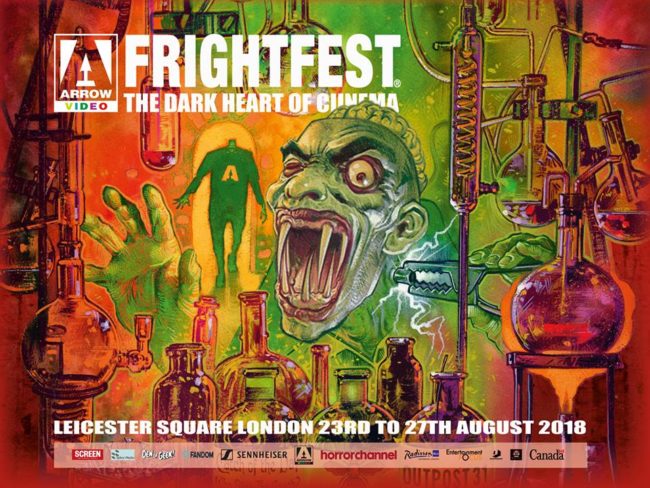
Traditionally first nights are a mixed bag, with less impressive showings like Cherry Tree, Cell and Death Note being among the early showings for the last few years. Still, as per the fried food and coffee combo at the hotel, it was more than enough to get me started. I have higher hopes for Day 2, with the latest efforts from Bousman and Laugier getting their European and UK premiers respectively. Showing up early, I start by perusing the stalls that’ll likely make a killing on DVD, t-shirt and book sales over the next few days. I chat away to fellow punters about the special editions and even take some recommendations. Something I’ve said before and will say again, is there’s a really friendly sense of community about Fright Fest, that gives off the feeling anyone can talk to anyone. Which brings me to this little ditty…
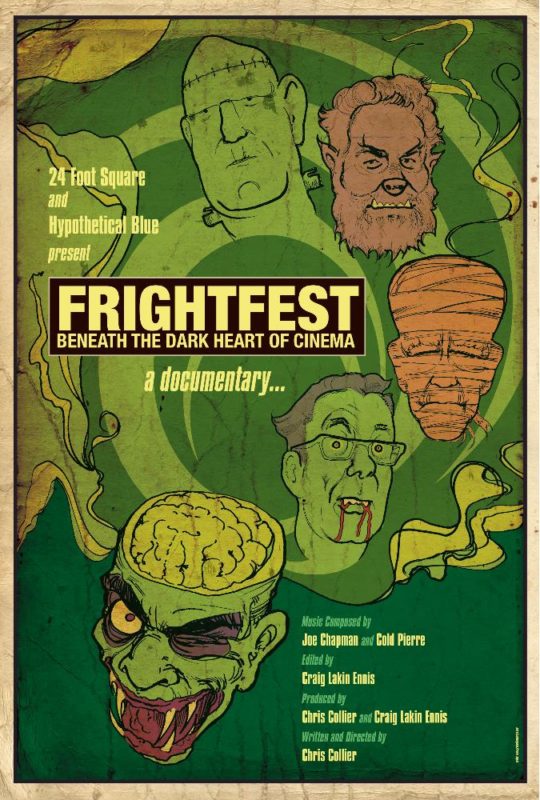
FRIGHTFEST: BENEATH THE DARK HEART OF CINEMA
Directed by Chris Collier
Fright Fest goes meta. In the first of two documentaries I’ll be seeing about the horror genre, the camera gets turned towards the audience and the fab four hosts. This warts-and-all account follows the development of my favourite festival from its humble origins, where it began as a hobby project for four fans, into Blighty’s biggest bloodbath. It’s clearly an earnest labour of love, and the hands-off approach from guys seems to have worked in its favour, with them being frank about each other along with the peaks and troughs alike. The narrative is roughly chronological, making stops to ponder the glory days at the old Empire, and along the way, some of the biggest names in horror show up to pay tribute: Adam Green, Eli Roth and Guillermo Del Toro. They’re also joined by some of the regulars, including a father-son combo that’ll get even the most stoic among us right in the feels. Together, they revisit the big events – awkward screenings (including the infamous Tulpa one), getting a movie pulled and 2012, when things fell apart at the seams.
As if it wasn’t clear enough already, this is a doc with a shamelessly niche audience: the festival scene, and those who get the many injokes. Mission accomplished – they will absolutely eat this up. There’s not enough about the meaning of horror as a whole to draw in a general audience. Nor is there enough dramatic tension, in the prospect of them moving cinema again, to have the sense of urgency some great works of non-fiction have. Really, the sub-topic, about the downfall of traditional cinema in the age of multiplex, is maybe the only attempt to up the scale of a clearly personal piece. Nonetheless, it was dead enjoyable to reflect on 19 years of the festival’s life. Seeing Joe Lynch say he felt at home with ‘like-minded psychos’, considering the crowd to be both freaks and geeks, was a nice reminder that its namesake more than just a weekend in a dark room. As was the, admittedly limited insight, into how the four oragnisers met to turn their shared enthusiasm into a calendar event.
Whether this is enough to get it distributed in future, I don’t know. But I think anyone who’s ever been to the dark heart of cinema will love it. Although as a Scot, I was left wondering why the Glasgow event never got mentioned. Mayhaps it was a timing thing. But seeing how the festival Twitter responded this year, to those trying to evade The Beast From The East, as they headed north, drummed in what it’s all about: community. I get this side of it – I’ve met a close buddy through the festival Twitter before, been with other friends and even braved the Megabus to Glasgow with me then flatmate. Perhaps it’s different now, going along as an author, or glorified blogger, rather than audience member means sodding off between movies to write this diary. It makes me a part of the festival but apart from the action. So on that, I’m going to stop being antisocial and stop here.
Rating: 




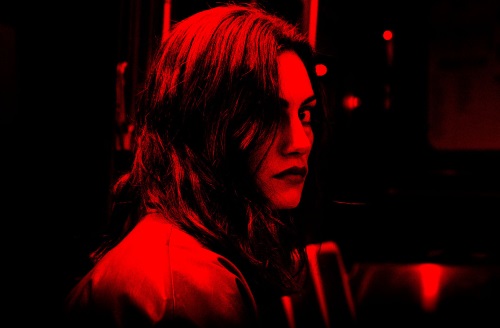
FINAL STOP
Directed by Roxanne Benjamin
At just seven minutes long, I normally wouldn’t have jumped at the chance to see Final Stop. But it isn’t just a screening of the, admittedly impressive, short, but a demonstration of 3D sound technology from audio industry leaders Sennheiser (nope, I’d never heard of them either). Hence we all got a headset on entry. It’s a smart, claustrophobic little picture, about something very every-day: a girl going home alone at night. As she gets on the bus, she feels like she’s being followed. It very quickly becomes apparent she’s right. This tense short, with an authentic trashy 80s style aesthetic, feels blood raw, and is a great watch in its own right.
However, it’s enhanced no end by the technology. 3D audio is not limited to the left and right panoramic of traditional surround sound. Instead, it’s a fully immersive experience, with the sound also coming from above and below. The result is a great contrast between the social cinematic experience and making it really immersive for individual viewers. It’s amazing to hear such a detailed soundscape, with twigs breaking at my feet, heavy breathing coming from behind and whistles off in the distance. The audio also fades organically into the visuals, with the sounds of party-goers coming closer before they burst in and sit beside our vulnerable woman. In fact, the result is so lifelike a lot of viewers may take it for granted. Frankly, it’s a must-hear experience and an engaging twist on a familiar fear.
Afterwards, director Roxanne took to the stage with some people from the audio industry, and Ranger director Jenn Wexler. They had an enlightening discussion about 3D sound and its role in cinema. At the moment, they reflected, it’s something of a wild west where there’s no standard code for its use – with a few experimental productions copping up now and then. All this may change, with headsets potentially offering something unique to the big screen experience. As with visual 3D, Horror may benefit from it in particular – with home invasion being one especially good example of how it can be applied. Personally, I’m all for it. I’m far from an audio junky, and tend not to notice a soundtrack unless it’s really good or really bad. But seeing how powerful it can be, even on a small-scale, makes me think it offers a lot of potential for immersion and engagement: the primal feelings horror thrives on.
Oh, and you can view it here
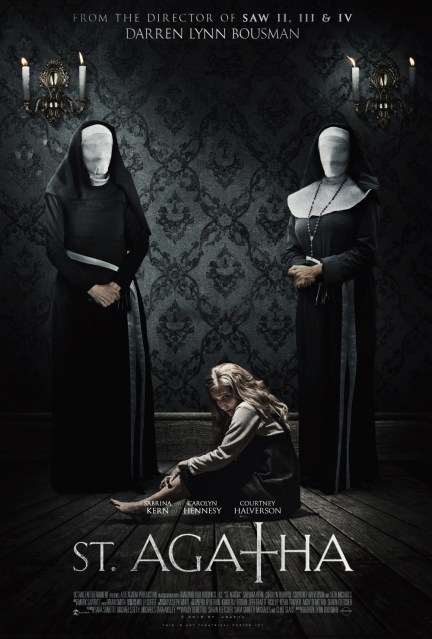
ST AGATHA
Directed by Darren Lynn Bousman
Two years ago, Darren Lynn Bousman said his next movie would have me scratching my head and saying ‘seriously?’ Mostly in a good way, he’s a man of his word. Though what’s maybe taken the wind out his sails is you wait years for a nunspoloitation flick to come out then two show up at once. To be fair, this 50s set melodrama isn’t similar to how the latest from the Conjuring extended universe looks since it isn’t supernatural. Yet it may later be done the disservice of getting written off as one of those smaller zeitgeist movies: A dark equivalent of Antz or Deep Impact. Regardless, St Agatha is the latest film from Saw 2-4/ Repo: The Genetic Opera helmer Bousman: a treasure trove of religious terror, that’s further evidence of him as one of the genre’s eclectic voices. For the most part of it we follow Mary, who’s no saint. She’s actually a con woman, that’s reached rock bottom. With nowhere else to turn, and a baby on the way, she seeks out refuge in a small-town convent off the beaten track. Sadly, a little warmth is too much to hope for as a Mother Superior, who could make Jigsaw say his prayers, sets about rebirthing her as the titular Agatha. As for her literal birth – she’s got plans for that too.
Darren Lynn has a weird track record. As per fellow former splat-pack contemporary Rob Zombie, each of his movies feels very much his, yet it’s rare to meet anyone that likes the lot of them. For instance, some lean towards the more sombre tone of Abattoir, rather than the dark carnival of Repo. St Agatha marks a bit of a departure for him, with the signature steampunk aesthetic all but taken out. His nightmarish soundtracks, with faded horns and industrial synth, are also replaced by traditional strings and haunting repetition of unnerving childish motifs. Even better is the silence, lots of eerie silence, that speak even louder. As usual, it’s got his pastel tints, giving an ethereal quality that could almost be taken from the pages of a comic-book. There’s still a tonne of gore, with a tongue scene to make sensitive viewers gag. It’s arguably less sadistic than the Saw films, although possibly nastier. None of this should be a surprise, since he’s always been a skilled visual artist, with a real sense of the macabre – and someone I’ve felt could make a genre masterpiece given the right material.
Unfortunately, it’s not this one. It’s still impressive enough. The story’s interesting, with plenty turns (albeit, building to a predictable reveal). The writers also raise the stakes regularly, resulting in an ever-growing sense of foreboding whenever Agatha undergoes more psychological torment. In addition, the main cast truly delivers, with Sabrina Kern (in her feature debut) throwing everything she’s got at it, whilst Carolyn Hennesy makes for a truly terrifying villain. The problem lies in its relentless pacing, that rarely lets off for the first two thirds. It’s like Bousman has an irrational phobia of boring people. Scenes are usually less than a minute long, and the very narrow focus on Mary/ Agatha means the supporting roles aren’t elaborated on, with other nuns relegated to saying functional dialogue and doing what the plot demands to set up the next scare. With few exceptions, almost every scene for the opening hour has something to make audiences wince and/ or squirm. Really, it’s rare to see a good film ease the pressure for its third act, but this actually benefits from it (and that’s not even to say the third act is slow!). To a point, its unyielding stride is great. Until, like American Horror Story, it adds up to a few gut punches too many. We no longer fear the consequences of Mary/ Agatha getting caught again because we’ve seen them several times over, becoming conditioned to her suffering. The resolution is satisfying, with things getting wrapped up as well as they could be – one overblown death scene, involving a novel weapon, is a standout. But nevertheless, it watches more like a rosary of great bits than a great film in its own right. Still, knowing the last thing Bousman wants is to be middle of the road, I’d challenge anyone to say they find it dull. Despite not loving it, I can’t wait to see what he comes out with next.
Rating: 




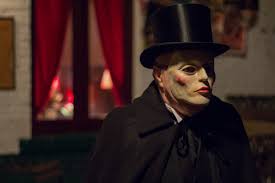
THE MOST ASSASSINATED WOMAN IN THE WORLD
Directed by Franck Ribiere
One I wasn’t expecting that much from, but found darn intriguing. Made with Netflix, this heavily fictional look at the life of Paula Maxa does what any semi-historic horror should by leaving me wanting to learn more about its topic. For those that haven’t heard of her, Maxa was something of a starlet of 1920s Paris (imagined here as a Victorian Hammer set). Well known for suffering on stage, legend has it that she died 10,000 times in over 60 different ways in front of gleeful audiences. This period horror/ drama is all about her, her fans, her influence and the world behind the curtains. As the subject for a contemporary horror, it’s a smart one, with the backstage setting allowing a look at the art of practical effects behind the many deaths. We see some being devised, practiced and mastered. More than showing that, the movie manages to deal with the moral basis, and consequences, of violence. It does this literally, in the form of a subplot about a killer stalking the streets nearby, seemingly inspired by Maxa’s mock-suffering. It’s also explored through dialogue in scenes with Paula and journalist/ love interest Jean, plus monologues from the theatre director, seemingly from the Black Swan school of subtext. Interestingly, many of them are disparaging to the cinematic experience, which is drummed in by a sequence paralleling the immersed theatre crowd and passive silver-screen one: a self-hating horror film.
The meta aspect of the storytelling extends to plays within plays, as some stunning visuals blend together Maxa’s memories and her art. To be fair, the whole movie looks stunning, with its theatricality imaginatively informing every frame. Then there’s the relationships, some of which are complex and others surprisingly sweet (Maxa and the blood/ props guy). Yet the script can’t keep a lid on them. With so much ambition, the third act struggles to contain it all, and several aspects are clumsily integrated. The movie is a rich fabric, yet many strands are simply not tied together in a satisfying manner. In particular, the serial killer thread doesn’t feel as if it goes anywhere: an intriguing build-up, with little functional purpose. The romance, on which the key dramatic moments depend on, also builds well but has a relatively small pay-off aside from giving a keyhole into the backing story. Then there’s the finale, that rests on the characters making a very dramatic decision that simply isn’t justified by the script, even if its thematically pleasing. Still, a generally good show all round – I’d love to see an extended cut as an encore.
Rating: 




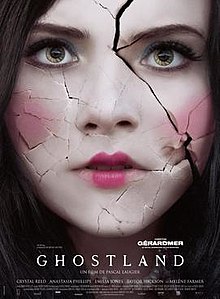
INCIDENT IN A GHOST LAND
Directed by Pascal Laugier
The one I was holding out for the most today. With Martyrs being my all-time favourite horror (I know I’m not meant to have one) I was glad to see its director return to the home invasion genre. Unlike his last offering, 2012’s The Tall Man, Incident at a Ghost Land is a back to basics, balls to the wall burst of intensity. It starts off simple, with a mother and two daughters, Beth and Vera, moving to a country house in the arse end of nowhere. It’s an eerie one, likened in dialogue to something from Rob Zombie, that had previously been owned before by a doll enthusiast with a hoarding problem. What follows is a horrific endevour , where they are terrorised by what seems to be a witch and an ogre who drive an ice cream van. Cut to many years later, and one of the little girls has now grown up to be, of all things, a horror writer, writing odd stories in the Lovecraftian tradition. However, the real monsters are still in her past. And following some nightmares about the night, and a troubling phone-call, she returns to face them, her trauma and that bad place she called home.
I’ll stop the summary there, as the second half goes to some unexpected terrains. Needless to say the central theme is dealing with trauma. It’s a bleak journey to the point of breaking, with some scenes as visceral as Martyrs’ worst. The triggering event is an exemplary slice of chaos –precarious, frantic and genuinely grueling. It gives full context to the characters’ anguish and only gets more horrific the more we learn about it. Pascal has the same sort of up close and personal violence as before, and some downright devilish imagery running throughout. There’s an almost oppressive, scrappy, physicality to the torture scenes that can make them hard to watch. It’s tense, ugly, and from about the halfway point rarely lets off. There’s also a clever, fiendish, twist that, whilst on face value is a bit gimmicky, allows for poignant dramatic stakes in the third act. It’s fiendishly structured, with an emotional weight that makes me wish it’d been part of an all-round smarter movie.
And that’s my chief gripe. What gets in the way of this being brilliant, and I appreciate if my day job wasn’t a psychologist I maybe wouldn’t care so much, is the grotesque depiction of mental illness/ disorders. First, we got our villains – a hyper-aggressive, crotch-sniffing, slobbering man-child who crudely caricatures the mentally handicapped. Then there’s another we know is meant to be ‘nuts’ because they wear a dress, with the source of fear not lying it who they are but entirely what they look like. It’s tough not to find such characterisation regressive and transphobic. No, villains don’t always need to be fully fleshed out – I can already hear Hughsey asking me about Meyers. But when their personalities are based wholly on representations of potentially problematic traits, do they need to be so thin? The cartoonish portrayals also significantly undermine the mental health theme running through it. Though that’s done further damage by Vera’s PTSD, which manifests in her being a feral, erratic doll hugger. It greatly diminishes the emotional impact and integrity of a film intent on dealing with sensitive subjects. As a result, it feels more mean-spirited and lazy than disturbing. The dolls motif also doesn’t seem to fulfil a deeper purpose than them looking a bit fucked up – which would be fine, if they didn’t show up every scene, likewise with the children’s records we’ve heard many times over. So all in all, a disappointment that it’s very easy to like but very difficult to love. At three to one, I’m wondering if Martyrs may have been a fluke.
Rating: 




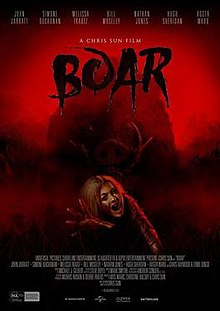
BOAR
Directed by Chris Sun
The title says it all – as per the 80s Razorback, this is a movie about a big god-damn pig the size of a rhino. A nasty fucker, with huge tusks, this oversized hog wants to defend its territory in the Aussie outback, against some city-slickers on a leisurely visit. Cut to a bunch of Sheilas and Dingos running for their lives, as it tramples anything in its path to get them (provided they’re in the countryside). It’s tricky to say much else about the plot, since that’s about the sum of it. If you think you’re above a movie about a huge boar trying to maul people, in a flurry of gory violence, then this isn’t for you. But if that’s what you want to see…
Boar evokes the fun, glorious stupidity of Orca over the subtle tension of Jaws. When the pig comes thundering on to the screen, to get one of the many victims on the ends of its tusks, it isn’t about scares as much as spectacle. It’s an intimidating looking porker, vicious to boot, and unquestionably the star of the show. Although its key victims, a holidaying family, are refreshingly very watchable too. In particular, Bill Moseley puts in a solid turn as the only yankee, being too darn nice for his own good and saying outlandish phrases (“I don’t wanna piss in your pocket”). But the strongest part is a surprisingly affecting centrepiece, where two old men (one of whom is played John Jarrett, aka Wolf Creek’s Mick Taylor) go camping to exchange crass jokes and contemplate their mortality. This prolonged, sequence, about so much and so little, could be a stunning short, or accomplished one act play, unto itself with a touching bittersweet pathos beneath the macho Aussie-man banter. It’s almost Samuel Beckett, had he been pissed on Fosters, and is my unexpected best bit of the fest so far. Elsewhere, the slice of small town life is well captured, including a fine cast of eccentric local characters you could gladly pull up a bar-stool beside and all evening with.
Here’s where the star rating system starts to fall apart. I’m not saying Boar is a better film than something like The Most Assassinated Woman in the World is per se, as its really not. However, it succeeds way more on its own terms, being everything you’d want from a creature feature. No, it’s not all a prime cut. Aside from giving its monster an oddly vampiric quality, the focus on night scenes, I expect was done for effects reasons, means there’s a lull during the second half. It also has a slight unfinished feel about it, with many deaths occurring off-screen, presumably likewise due to financial constraints. To be blunt, with a bigger budget, this could have been a better film, boasting more over the top gore and smarter kills. Yet I’d challenge people kicking back with a beer and crisps not love it. A perfect midnight movie.
Rating: 




I arrive back around two in the morning, bringing a long day to a close. Still no modern classics this year, with Summer of 84 and Boar being the unexpected highlights. But still, I’ve gotten my teeth into lots of decent stuff. Let’s see what tomorrow brings.
You can catch up with coverage of day 1 here



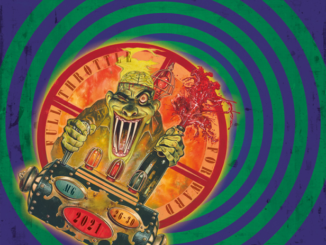
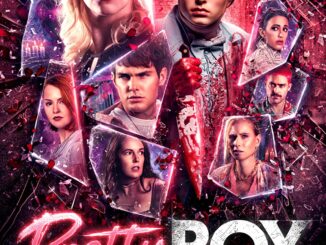
Be the first to comment